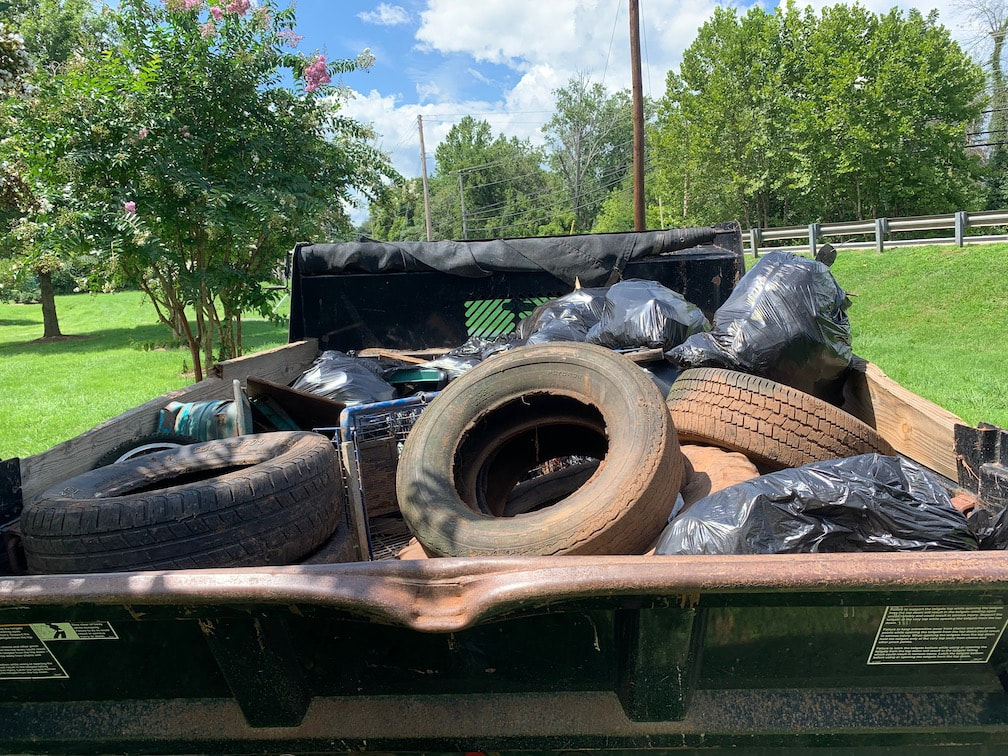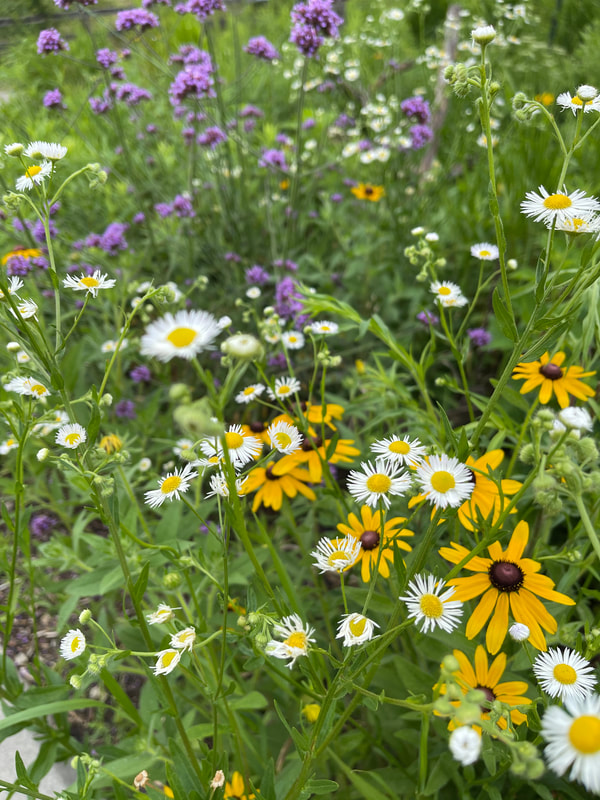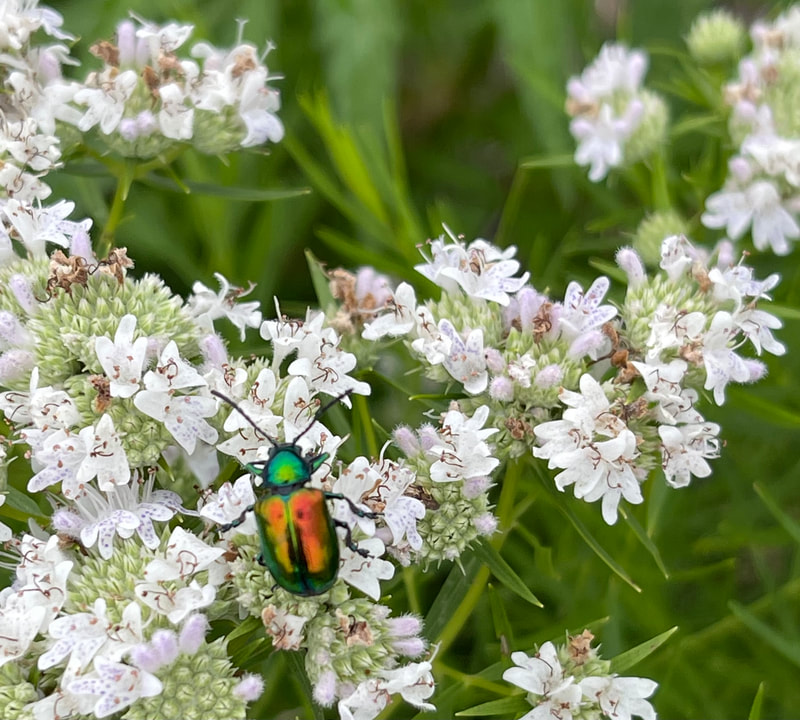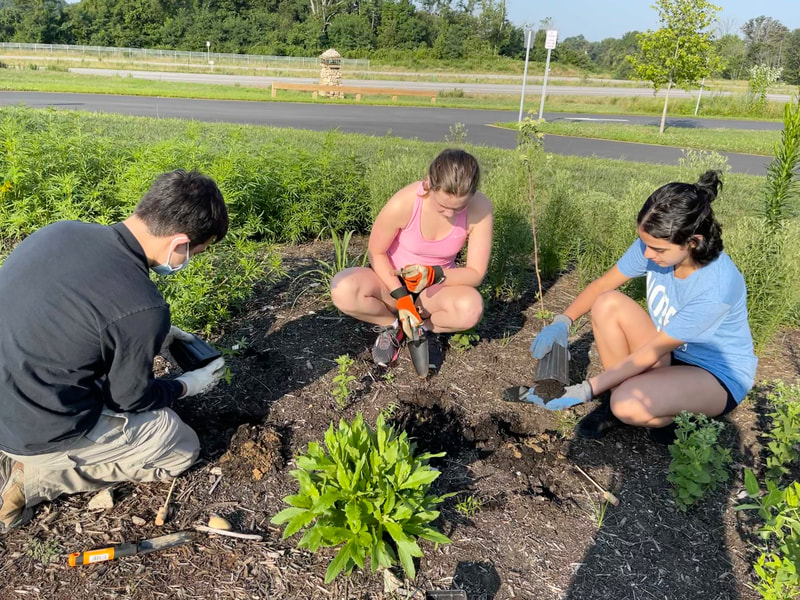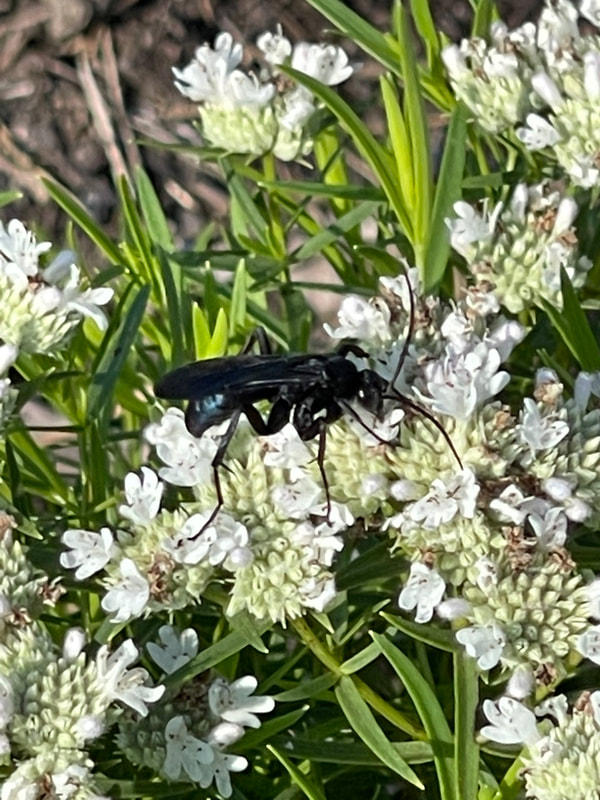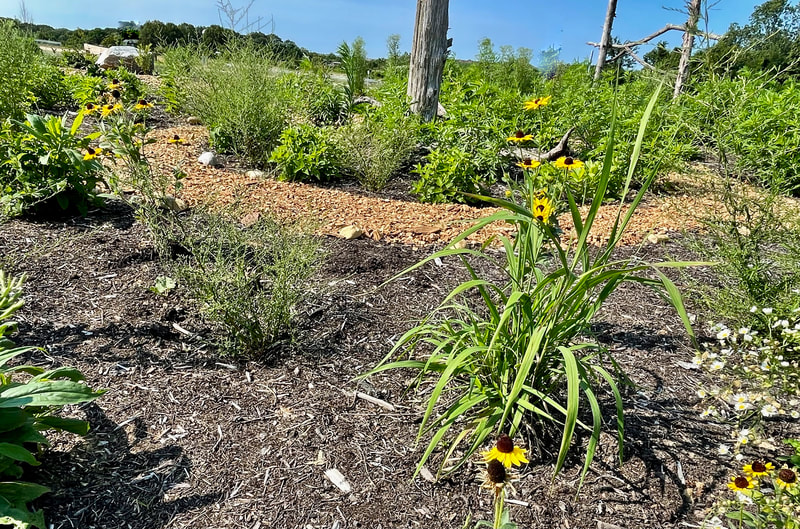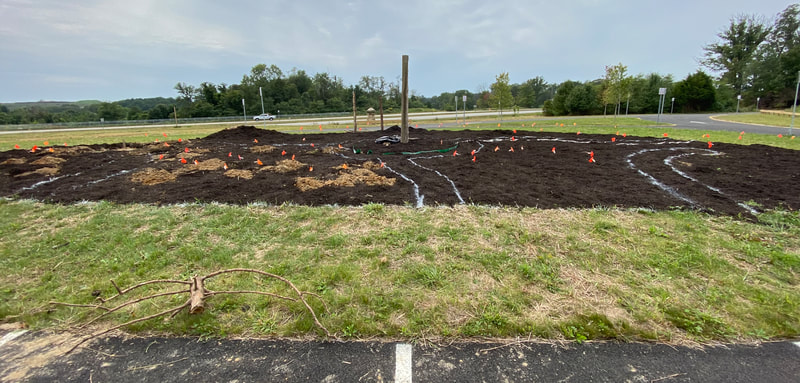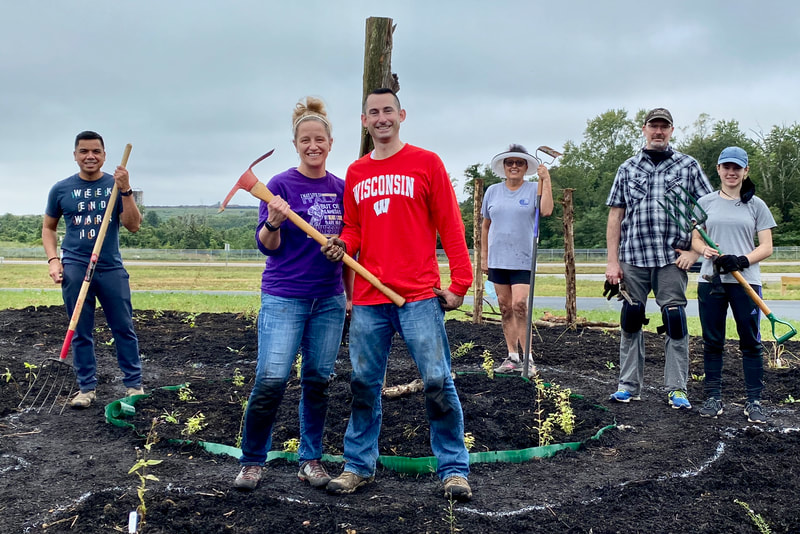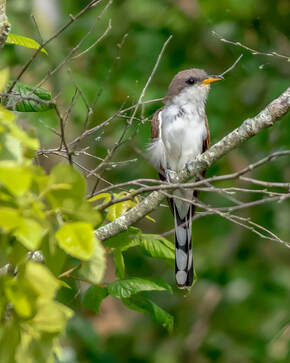Laurels – Summer 2021
Ike Isenhauer (VMN-Shenandoah Chapter) and David Youker (VMN-Historic Rivers Chapter) are the two most recent volunteers to have contributed 5,000 hours of volunteer service in their Virginia Master Naturalist volunteer roles. Ike contributes much of his service with the Blue Ridge Wildlife Center, while David has focused on bird-related projects such as prothonotary warbler nest box monitoring and Christmas Bird Counts. Thank you, Ike and David, for your service!
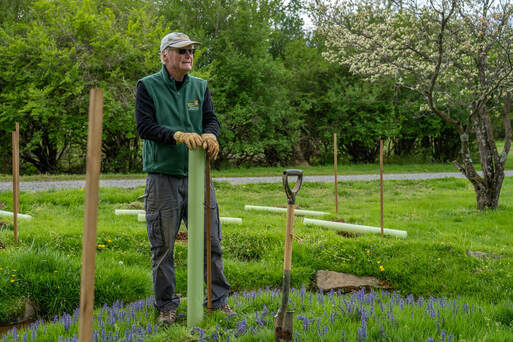 Barry Buschow, VMN volunteer and president of the Old Rag Chapter, plants trees at Monroe Park in Fauquier County, VA to help protect the Rappahannock River watershed.
Barry Buschow, VMN volunteer and president of the Old Rag Chapter, plants trees at Monroe Park in Fauquier County, VA to help protect the Rappahannock River watershed.
Contributed by Bonnie Beers, Alejandro Bueno, and Charlene Uhl (VMN-Old Rag Chapter), and October Greenfield (Friends of the Rappahannock)
Old Rag Master Naturalists (ORMN) and our president, Barry Buschow, were recognized this spring at the annual awards program of the Friends of the Rappahannock (FOR) for ORMN’s extraordinary contributions in supporting the health of the Rappahannock River watershed. This river runs 195 miles from the Blue Ridge Mountains across the Piedmont into the Chesapeake Bay south of the Potomac. It is a critically important part of the Virginia watershed, draining an area of 2,848 square miles and approximately 6% of Virginia.
Since 1985 Friends of the Rappahannock has been actively working to improve the water quality of this vital watershed through tree planting, restoration of banks, restoration of oyster reefs and living shorelines downstream, removing trash and actively promoting rain gardens and other landscape practices that reduce runoff and pollutants.
- ORMN was awarded the Upper Rappahannock Conservation Partner of the Year and our members were recognized for “going above and beyond” with tree plantings, river cleanups, water quality monitoring and educational programs. ORMN has four approved volunteer projects with FOR encompassing Citizen Science, Education and Stewardship. Since the beginning of 2021, almost 20% of ORMN active volunteers had recorded dedicated hours for FOR projects. FOR expressed specific gratitude for the strong presence of ORMN volunteers at a Park Cleanup at Culpeper County’s Lenn Park in 2020, a planting at Old House Vineyards in Culpeper, and a planting at Pen Druid Brewery in Sperryville.
- Barry Buschow was presented the Volunteer of the Year Award for his many efforts across multiple counties where the Rappahannock flows. He is now trained as one of FOR water quality monitors. October Greenfield, FOR’s Upper River Steward, noted that “Barry’s curiosity and love for the natural world is an inspiration to all of us and we are appreciative of all of his hard work.”
Contributed by Jennifer Ambs, VMN-Pocahontas Chapter
VMN volunteer Jennifer Ambs (Pocahontas Chapter) has published a new book telling the story of Bright Hope Butterfly Garden, a large, public Monarch Waystation in Chesterfield, VA. The BHBG mission is butterfly conservation, education, citizen science and enjoyment. The goal of this book is to show the reader there is more to gardening for monarchs than meets the eye, It intends to provide a glimpse (even beyond what can be observed), of some of the plants and insects that are part of the garden’s multifaceted ecological community. It also details, through interviews with and reflections from the friends and volunteers of the Bright Hope Butterfly Garden, how butterfly conservation has influenced them, enhanced their lives, and strengthened their position as environmental stewards. Katherine Snavely, formerly of the Riverine Chapter and a BHBG volunteer, made a large contribution to the book and submitted several pages including information about milkweed tussock moths and honeybees. All of the photos, with a few exceptions, were taken at Bright Hope Butterfly Garden (with cell phones) by the friends and volunteers of the project. Profits from this book will be used toward in-kind donations for BHBG maintenance as well as related outreach and educational endeavors. Profits from the sales of this book will also go to other butterfly habitat projects as deemed suitable. While Jennifer wrote and published the book as a personal rather than VMN endeavor, it is a lovely tribute to the impacts of the butterfly garden project and an educational tool that will hopefully inspire new audiences to create pollinator habitat.
Check out the photos below, all contributed by Jennifer Ambs, to see some members of the fabulous Bright Hope Butterfly Garden team!
Contributed by Susan Laume, VMN-Fairfax Chapter
A Virginia Master Naturalist led effort, supported by over two dozen amateur gardeners, literally bloomed to fruition this spring in Laurel Hill Park in Lorton. Many of the volunteers had done no gardening of any kind before, and had no knowledge about native versus non-native plant species. However, willing hands and sustained effort over several months turned one weed-choked, and one barren parking lot island into two native plant gardens, welcoming to pollinators and park users, mirroring only the native wildflowers and grasses found throughout the park.
This is a story about one of many collaborative efforts between Master Naturalists and our friends in the Fairfax County Park Authority. Under the auspices of the Laurel Hill Park Volunteer Team (PVT) founded by the author, the park area maintenance manager designated the garden development areas. He also provided limited start up assistance by way of dumping wood mulch, and amending mowing contracts to protect the garden areas. The Park Authority assisted with advertising for members through the county volunteer opportunities system. The first garden involved merely managing the volunteer plants which populated the space. For the second garden, the County also authorized limited funding for starter plant purchases through the native plant nursery, “Earth Sangha”. Garden design, bed preparation, mulch spreading, planting, establishment watering, weeding, and subsequent plantings for both garden locations were all accomplished by a changing set of citizen volunteers.
With the first garden started in May 2020, and the second in September 2020, progress in both was slowed by Covid -19 park restrictions. Spring 2021 was the first opportunity to see real results of the efforts in terms of blooms and visiting pollinators. While the full beauty of the gardens is yet to blossom, the gardens already have accomplished much (see photos below). Dozens of people have worked there and now know about native plants and their importance to our environment. Many more have visited the garden and asked about its purpose and plants. Dragonflies, bees, beetles, wasps, bugs, and birds visit regularly, enjoying the diversity of plants created by management of the space. Small mammals and snakes move and hide within the grasses and green, drawn by the food now found there. In coming seasons, as the gardens fill with more plants, both planted and seed volunteers, they will continue to achieve their goal — welcoming and educating people about the beauty and wonder of native plants.
Contributed by JoAnn Jones (VMN-Central Piedmont Chapter)
A recent issue of Cooperative Living magazine featured an article about VMN volunteers Al and Betsy Lookofsky (Central Piedmont Chapter). Among the many projects that the Lookofskys participate in is the white oak genetics study with the University of Kentucky. In this project, volunteers collect acorns and twigs from white oaks in their geographic area. Scientists are using this genetic material to identify and produce superior white oak seedlings to help address the issue of low regeneration in this tree species, which is of critical importance ecologically and in the forestry industry. Showing the kind of leadership and motivation that we love to see in VMN volunteers, Al and Betsy called their local electrical cooperative (Southside Electric Cooperative) to ask if they could provide a bucket truck to come to their farm to help collect twigs from high up in some of the white oak trees on their farm. These twigs are important for successful grafting in the project. The Cooperative was interested in helping and arranged for one of their contractors to assist.
“Other VMN volunteers have helped with the white oak genetics project, too! “One very important partner group is citizen scientists in the Master Naturalist program. These volunteers have helped collect over 60,000 acorns from 200 parent trees. This is the very way we came to know of the Lookofskys. To date, their acorns and scions are producing some of our best seedings.” (Tree Improvement Specialist Dr. Laura E. DeWald, University of Kentucky, as quoted in the Cooperative Living article by Communications Specialist Jennifer Wall, August 2021 issue.)
Contributed by Linda Eanes, Virginia Cooperative Extension
For many years in a row, the VMN Central Piedmont Chapter has partnered with 4-H and Bear Creek Lake State Park to provide the Wildlife Detectives day camp for area youth. VMN volunteers lead all kinds of wildlife-related activities while helping the youth connect to nature outdoors at the park. VMN volunteer Mary Ames created a fabulous video that gives you a wonderful sense of how much the youth enjoy the opportunity and the different ways they are learning about wildlife.
Note: This video does not have narration, and thus is not captioned.
Contributed by Susan Sims, VMN-Banshee Reeks Chapter
The VMN Banshee Reeks Chapter has helped bring a new nature play area for children in Loudoun County. The project is a collaboration among the VMN chapter, the Blue Ridge Center for Environmental Stewardship, and the Loudoun Wildlife Conservancy, and was funded by a grant from the Virginia Environmental Education Association. Volunteers helped design and build the play area. Read more about it in the Loudoun Times.
This is one of several nature play areas that VMN volunteers have had a hand in creating. Others include the Children’s Discovery Area at Sky Meadows State Park and the Parker the Red Fox Discovery Area at Hungry Mother State Park.
Has your VMN chapter been responsible for creating another public nature play area for youth in your area? Contact the VMN state office to share stories of your nature play area projects.
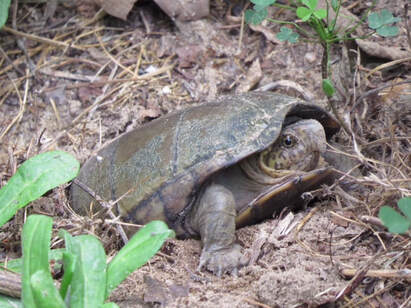 Turtle at Jamestown Island. Photo by Nancy Barnhart, VMN-Historic Rivers Chapter.
Turtle at Jamestown Island. Photo by Nancy Barnhart, VMN-Historic Rivers Chapter.
Contributed by Nancy Barnhart, Shirley Devan, and Ricklin Brown, VMN-Historic Rivers Chapter
Jamestown Island, a low-lying island jutting into the James River, is owned by the National Park Service (NPS) as part of Colonial National Historical Park. A popular feature of the island is the 5 mile paved tour road which can be driven, walked, or bicycled by Park visitors. The range of habitats on the island includes southern mixed hardwood forest, interior hardwood swamp, tidal salt marsh, riverfront, and the open water of the James River. It is home to a wide variety of wildlife including 8 species of turtles.
The NPS is committed to species protection and is sensitive to human/wildlife interaction. Observations by visitors and staff over time, but increasingly more frequent this spring, pointed to a rise in the number of turtle mortalities on the loop road. This led to the initiation of a concerted effort to document turtle activity on the island with the goal of minimizing human impact on turtles and other herpetofauna.
The Historic Rivers Chapter of VMN has partnered with the NPS on a number of projects, including marsh bird monitoring, breeding bird surveys, butterfly counts and wildlife mapping. So it was natural for the NPS to call on the members of HRC to take-on the project of Turtle Mortality Monitoring. Led by Nancy Barnhart a team of volunteers began monitoring on Memorial Day weekend. Monitoring requires completing the entire 5 mile tour road, on foot, bicycle or by car, at 9:00 a.m. and 3:00 p.m. every day through October. Volunteers sign up for slots online and can go individually or with a partner. We document live and dead turtles that we come across as we travel the road. We obtain a GPS location, identify the species, take photos and sweep roadkill from the road to prevent a recount by the next monitor. We complete data sheets after each survey noting such items as micro habitat (shady, sunny) habitat type (marsh, forest, etc), weather, species and GPS locations. We note nesting and egg laying when observed and any other pertinent information. Data sheets are sent electronically to the Natural Resource Specialist after each survey. A report of 6 or more dead turtles in a day triggers closure of the tour road to vehicles for at least a day, often more, as it indicates an increase in activity. Data that HRC volunteers collect will contribute to science-based analysis and help guide a future NPS management plan to reduce turtle mortality.
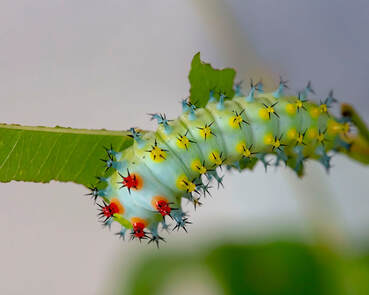 Cecropia moth caterpillar. Photo by Judy Jones, VMN-Historic Rivers Chapter.
Cecropia moth caterpillar. Photo by Judy Jones, VMN-Historic Rivers Chapter.
VMN-Historic Rivers volunteer Judy Jones had not one, but two photos selected for publication in the Virginia Department of Wildlife Resource’s Annual Photography Showcase issue of Virginia Wildlife. Both photos were selected for the Virginia Fauna category from nearly 600 entries. Congratulations, Judy–and any other VMN volunteers who may also have had winning photos!
Excerpted and adapted from Shenandoah Saw-whet, the newsletter of the VMN-Shenandoah Chapter
It’s hard to find a Shenandoah Chapter VMN project that Mary Keith Ruffner has not been involved with. The Sensory Trail, Outdoor Lab, Pollinator Plots, three different Bluebird Trails at Sky Meadows, Blandy, and SCBI,… Mary Keith has given so much of her time and effort to all of these very important chapter projects. In recognition of those tireless efforts, Mary Keith has been named the Shenandoah Chapter’s 2020 Volunteer of the Year. But wait, there’s more: Mary Keith has also been named volunteer of the year at the chapter’s partner site Sky Meadows State Park. Two awards in one year makes it clear just how dedicated Mary Keith is!
For Mary Keith, it started with bluebird monitoring – helping Margaret Wester at Sky Meadows State Park and Blandy Experiemental Farm. The efforts were instrumental to the foundation of the Bluebird Trail at Sky Meadows which is celebrating its 10-year anniversary in 2021. Mary Keith has also contributed to other works at Sky Meadows, such as a pollinator plot project, the Sensory Trail, and invasive plant removal workdays.
Her VMN training led Mary Keith to develop a real appreciation for the vast diversity found in our Shenandoah Chapter’s territory. When asked what area she likes most, she immediately responded, “all of it”; adding there is such richness of opportunity in the area. She especially appreciates the more iconic locations of Sky Meadows State Park, Blandy Experimental Farm, Thompson Wildlife Management Area, and Shenandoah River State Park.
Congrats to Mary Keith – a double volunteer of the year award recipient!
Suzanne Moss, VMN volunteer in the Tidewater Chapter, was recently spotlighted for her Nature Bus business and programs. Although the Nature Bus is separate from her VMN role, it is an example of cool things VMN volunteers do in nature and environmental education in their “off” time!
Contributed by Ida Swenson, VMN-Rivanna Chapter
Walter Hussey, VMN-Rivanna Chapter, has coordinated a project to plant a new grove of American Chestnut trees at Pleasant Grove Park in Palmyra, Virginia. It’s been a collaboration with Fluvanna County Parks and Recreation, Fluvanna Master Gardeners, Charlottesville Area Tree Stewards, and the Virginia Department of Forestry, along with others in his VMN chapter. Read more about it in the Fluvanna Review!
Laurels – Summer 2021 Read Post »

